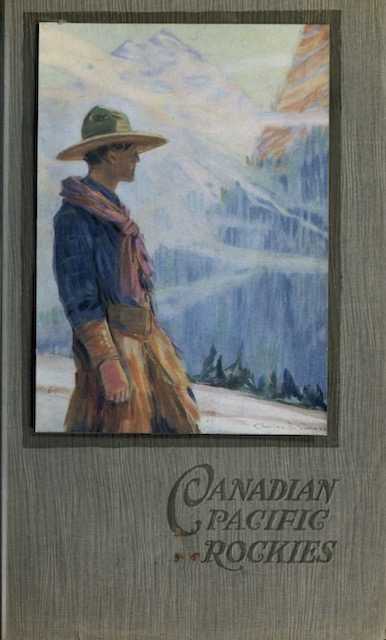This fancy booklet is supposed to look like it was printed on wood, or at least wood-grained paper. It includes 17 color illustrations that are glued onto the pages.
 Click image to download an 8.7-MB PDF of this 36-page booklet.
Click image to download an 8.7-MB PDF of this 36-page booklet.
The text was written by Betty Thornley, about whom I can find little information other than she wrote several travel booklets for Canadian Pacific, starting with a 1917 publication on St. Andrews in New Brunswick, Acadia (Nova Scotia) in about 1919 or 1920, CP’s bungalow camps in 1923, and Quebec in 1930. She was also a frequent contributor to Vogue magazine, often with articles about CP destinations such as Banff or Asia. I suspect her writings about World War I caught the attention of the railway’s marketing department, which contracted with her for various publications.
This particular booklet is undated. I downloaded it from archive.org, which got it from the Toronto library. The library guessed it is from 1900, but that’s wrong: page 11 has an illustration of the Banff Springs Hotel as it appeared between 1914 and 1928, and based on the other dates it doesn’t seem that Thornley did any work for CP before World War I. I would conservatively date this to 1925, but it was probably a little earlier.
The title page credits the illustrations to “C.W. Simpson, Oliver Dennett Grover, Carl Rungius, and G.B. Mitchell.” In fact, 12 out of 17 of the paintings were done by Montreal landscape artist Charles Walter Simpson (1878-1942). Simpson’s work can be found in other Canadian Pacific, and possibly some Canadian National, publications.
Only one painting is clearly attributed to wildlife artist Rungius (1869-1959). Born in Germany, Rungius visited Wyoming in 1895, which persuaded him to immigrate to the U.S. permanently. Apparently headquartered in New York, he painting animals and landscapes all over the western United States and Canada. His painting in this booklet shows a pack train of horses climbing over the Rockies.
George Bertrand Mitchell (1874-1966) was a Massachusetts-born artist who worked for an advertising agency that represented Canadian Pacific and in that role he did many paintings of Blackfeet Indians including, possibly, some of the ones we’ve seen on menu covers. His painting in this booklet shows a campsite with Mount Assiniboine in the background.
That leaves three paintings whose signatures are unclear, but at least one of them must have been done by Grover (1861-1927), an Illinois landscape artist who studied at and later taught at the Art Institute of Chicago. The paintings with no or unclear signatures include the Banff golf course, the Bow River, and Emerald Lake.
Although this booklet is available on archive.org, the scans are so dark that the text is practically unreadable. I lightened it up (though it is still pretty dark) and restored some of the pictures.
